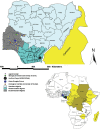Serological Detection of Ebola Virus Exposures in Native Non-human Primates of Southern Nigeria
- PMID: 30864758
- PMCID: PMC7377558
- DOI: 10.2991/j.jegh.2018.05.001
Serological Detection of Ebola Virus Exposures in Native Non-human Primates of Southern Nigeria
Abstract
Ebola viruses (family: Filoviridae) are the cause of Ebola virus disease (EVD), a highly fatal illness characterised by haemorrhagic fever syndrome in both humans and non-human primates (NHPs). West Africa was the epicentre of the 2013-2015 EVD epidemic which caused the death of over 11,000 people, including eight casualties in southern Nigeria. Antibodies to filoviruses have been detected among NHPs in some countries, but there is no documented evidence of exposures to filoviruses among NHPs in Nigeria. From August 2015 to February 2017, a total of 142 serum samples were obtained from individual captive and wild animals, belonging to 11 NHP species, in southern Nigeria, and screened for species-specific antibodies to filoviruses belonging to the species; Zaire ebolavirus [Ebola virus (EBOV)], Sudan ebolavirus [Sudan virus (SUDV)], and Marburg marburgvirus [Ravn virus (RAVV)]-using a modified filovirus species-specific ELISA technique. Of the sera tested, 2.1% (3/142) were positive for antibodies to EBOV. The entire 142 sera were negative for SUDV or RAVV. These findings point to the existence of natural exposures of NHPs in southern Nigeria to EBOV. There is need to discourage, the uncontrolled hunting of NHPs in Nigeria for public health safety.
Keywords: Filoviridae; monkey; wildlife; zoonosis.
© Atlantis Press International B.V.
Conflict of interest statement
None.
Figures


References
-
- World Health Organization Statement on the 1st meeting of the IHR emergency committee on the 2014 Ebola outbreak in West Africa. http://www.who.int/mediacentre/news/statements/2014/ebola-20140808/en/; 2014 [accessed 15.09.17].
-
- Kuhn JH, Bao Y, Bavari S, Becker S, Bradfute S, Barister JR, et al. Virus nomenclature below the species level: a standardized nomenclature for natural variants of viruses assigned to the family Filoviridae. Arch Virol. 2013;158:301–11. https://www.ncbi.nlm.nih.gov/pubmed/23001720. - PMC - PubMed
-
- Centers for Disease Control About Ebola hemorrhagic fever. http://www.cdc.gov/vhf/ebola/about.html, [accessed 23.08.17].
-
- Rajak H, Jain DK, Singh A, Sharma AK, Dixit A. Ebola virus disease: past, present and future. Asi-Pac J Trop Biomed. 2015;5:337–43. doi: 10.1016/s2221-1691(15)30365-8. - DOI
MeSH terms
Substances
LinkOut - more resources
Full Text Sources
Medical
